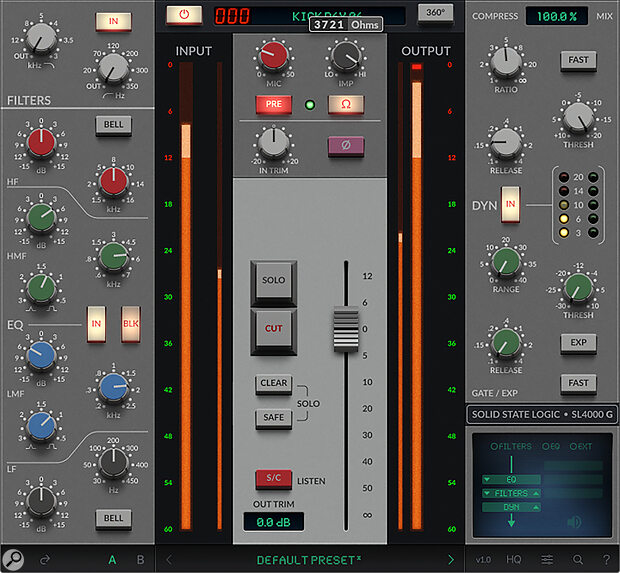The latest addition to SSL’s Plug‑in Mixer brings some ’80s goodness to your mixes.
The Solid State Logic 4000 mixer is the gift that keeps giving. Despite their age, 4k E‑series and G‑series desks are still delivering hit mixes around the world. And for those who lack the space or budget, SSL have developed several alternative ways to access the same sound and feature set. The latest is a channel strip plug‑in called 4K G, available in all common native formats for macOS and Windows and authorised using the iLok system.
Being an emulation of the 4000 G‑series channel strip, 4K G has variable high‑ and low‑pass filters, plus a four‑band EQ in which the two middle bands are fully parametric. It has the familiar SSL channel dynamics. And it also emulates the 4k console’s mic preamp, with the addition of a pot that varies the input impedance. A fader, pan pot, mute and solo buttons duplicate functions that are available in your DAW’s mixer, but are included here because the 4K G plug‑in is part of SSL’s 360 universe and hence the alternative SSL Plug‑in Mixer. This also explains its layout, which is designed so that the EQ and dynamics controls map perfectly onto SSL’s UC1 surface.
The EQ and filter sections feel like old friends even if you’ve never sat behind an SSL console.
Joining The Band
The EQ and filter sections feel like old friends even if you’ve never sat behind an SSL console, as their design has influenced so many others over the years. The two parametric bands are flexible enough for surgical cuts or broader tone‑shaping, the filters cover all the territory you’ll need and the high and low shelving bands enable you to quickly dial in the right amount of air or thump. The icing on the cake is a button that switches the frequency ranges between those used on the ‘pink’ and ‘black’ iterations of the SSL EQ. Depending on the source, toggling this can make a surprising difference.
If you’re used to more comprehensive plug‑in compressors, the 4K G dynamics section might at first seem limiting (no pun intended). Ratio, threshold and release time are freely variable, but there’s a choice of only two fixed attack times, and make‑up gain is either automatic or off. In practice, though, it’s perfectly flexible enough for the vast majority of bread and butter mixing roles, and its simplicity means you can set it up in seconds. SSL have also added a mix control to enable its use as a parallel processor. The EQ can be switched into the compressor side‑chain, compensating for the lack of a dedicated de‑esser section, and it’s possible to select an external side‑chain signal. The order of the filters, EQ and compressor can also be varied. The expander/gate is perhaps less useful in a digital world than it was when people were mixing huge projects from tape, but does its job smoothly and confidently.
Shut Up & Drive
So far, so typical of SSL channel strip plug‑ins we already have in our armouries, but SSL have given 4K G some points of difference too. If you like to vary the Sides level on a channel‑by‑channel basis, the Width control does exactly that. And while the SSL preamp circuit might not have the legendary status of its counterparts from Neve or API, overloading it certainly adds some grit and midrange emphasis to the sound. Many engineers who still work on SSL consoles value the colour that can be imparted by driving them hard; enabling the preamp emulation on every channel in a DAW mix won’t sound identical, but achieves something similar. Finally, the impedance knob runs from 6200Ω at its clockwise extreme — the default setting — right down to 1Ω at the other. Treated subtly, it’s a surprisingly effective and usable way of toning down over‑bright cymbals in drum overheads, for example. These extras are sweet icing on an already tasty cake!
Summary
A slick and well thought‑out software rendering of the classic SSL 4000 G‑series channel strip.

